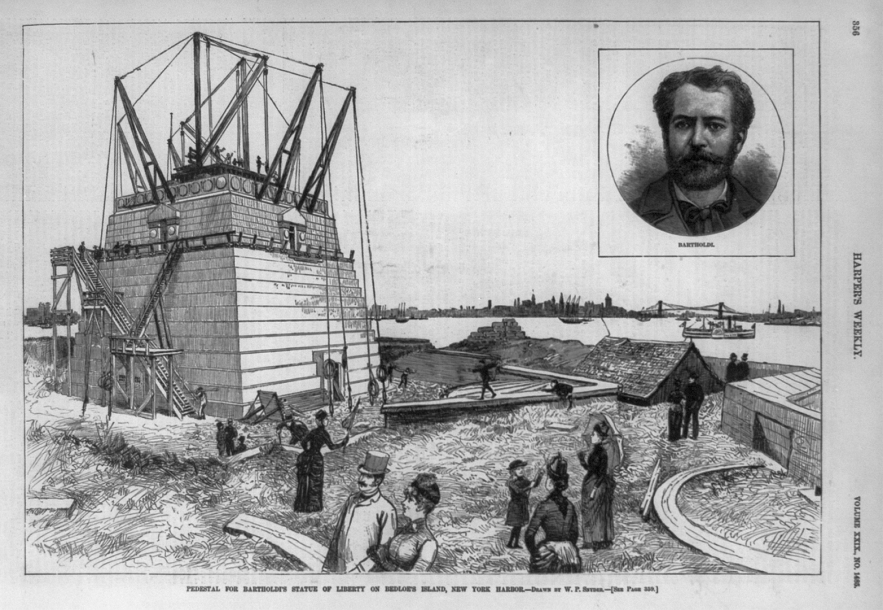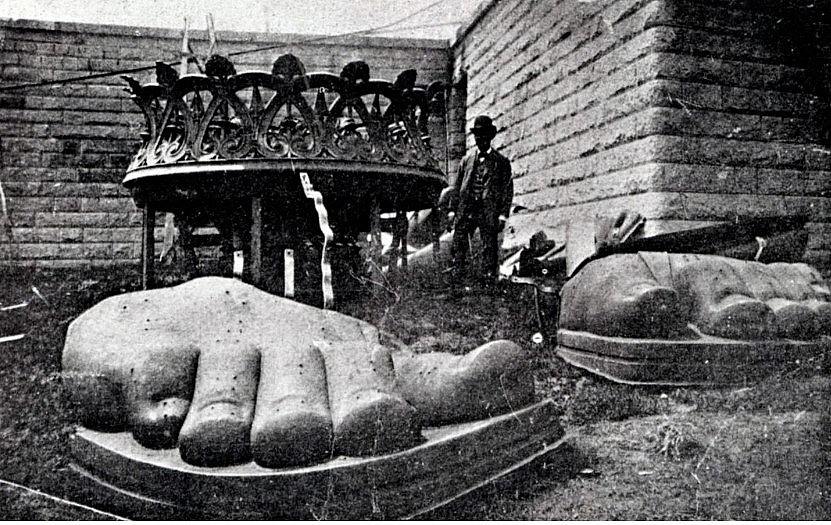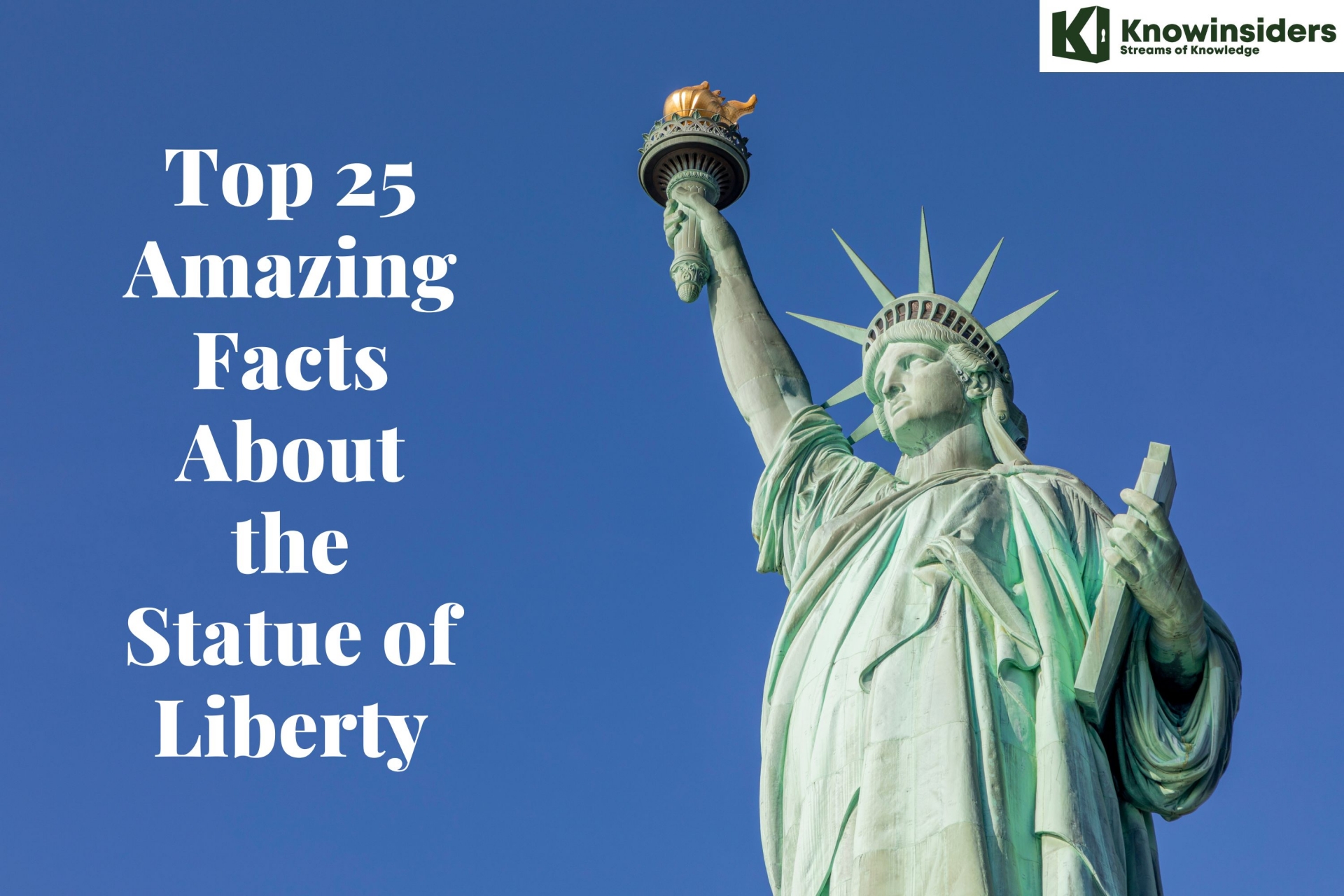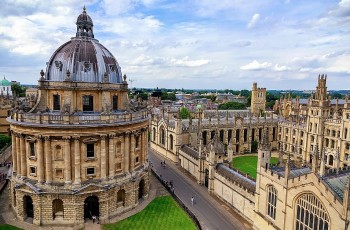History of the Statue of Liberty: TimeLine, Interesting Facts and Origins
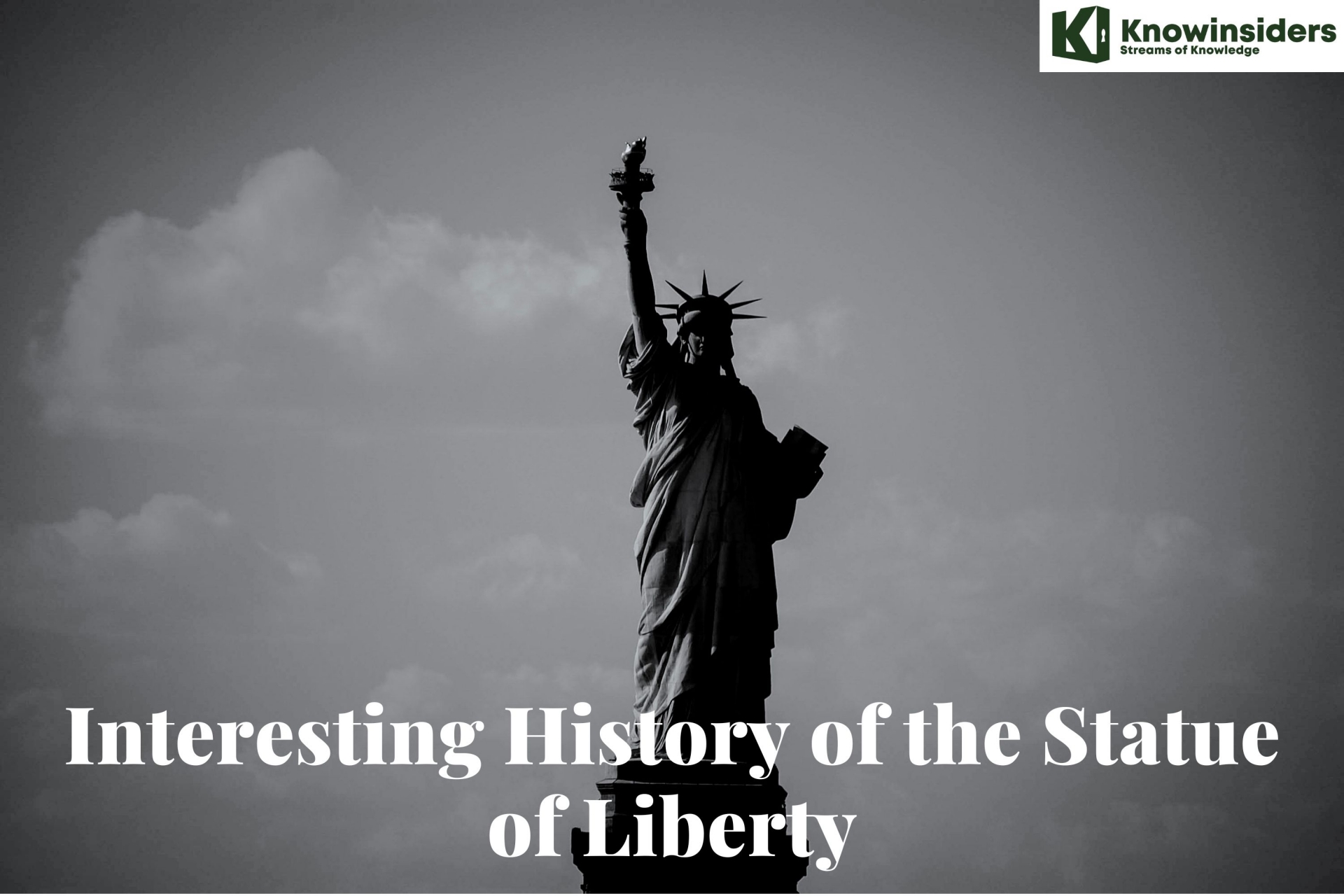 |
| Interesting History of the Statue of Liberty |
| Table of Content |
On July 4, 1884 France presented the United States with an incredible birthday gift: the Statue of Liberty! Without its pedestal, it’s as tall as a 15-story building.
She represents the United States. But the world-famous Statue of Liberty standing in New York Harbor was built in France. The statue was presented to the U.S., taken apart, shipped across the Atlantic Ocean in crates, and rebuilt in the U.S. It was France’s gift to the American people.
The long and complicated journey she took from France to the shores of New York is an unforgettable story. But what happened along the way? How much money was involved? Who does she resemble?
| “To see that beautiful lady, lifting high her beacon of liberty, few had language to describe the feeling…our tears were our only words.” – Isabel Belarsky, 1930 |
Story in A Timeline
1865
At dinner party, Edouard Laboulaye, chairman of French anti-slavery society, proposes monument to liberty and U.S. independence in centennial year (1876); sculptor Frederic Auguste Bartholdi attends.
French historian Edouard de Laboulaye suggests that France create a statue to give to the United States to celebrate its success in building a democracy.
| • The U.S. Civil War ends. • U.S. President Abraham Lincoln is assassinated. |
1867
Bartholdi proposes huge statue of robed woman holding torch ("Egypt Bringing the Light to Asia") for opening of Suez Canal (1869). The idea is unsuccessful.
| • Russia sells Alaska to The United States. |
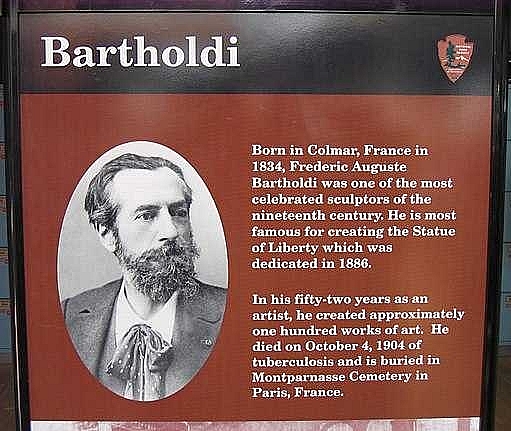 |
| The French sculptor Frédéric Auguste Bartholdi |
1870
The French sculptor Frédéric Auguste Bartholdi begins sketching the Statue of Liberty.
1871
Bartholdi seeks Laboulaye's aid in trip to United States, arrives in New York (June); tours country promoting idea of Franco-American monument on Bedloe's Island in New York Harbor.
1872
Bartholdi returns to France.
1875
Franco-American Union created in France, committee approves Bartholdi's plaster model of "Liberty Enlightening the World," begins fundraising 600,000 francs; Laboulaye presents formal request to President U.S. Grant through Ambassador Levi P. Morton to use Bedloe's Island site for monument.
1876
Bartholdi begins constructing statue, completes hand and torch, which are sent to U.S. for display at Centennial Exposition in Philadelphia (August 14); Bartholdi returns to U.S. May 6; hand and torch shipped to New York, displayed at Madison Square.
1877
Outgoing President Grant signs bill designating Bedloe's Island for proposed monument (March), U.S. fundraising of $250,000 begins; Tuileries diorama unveiled; Grant visits Paris (November); statue construction continues, French fundraising continues.
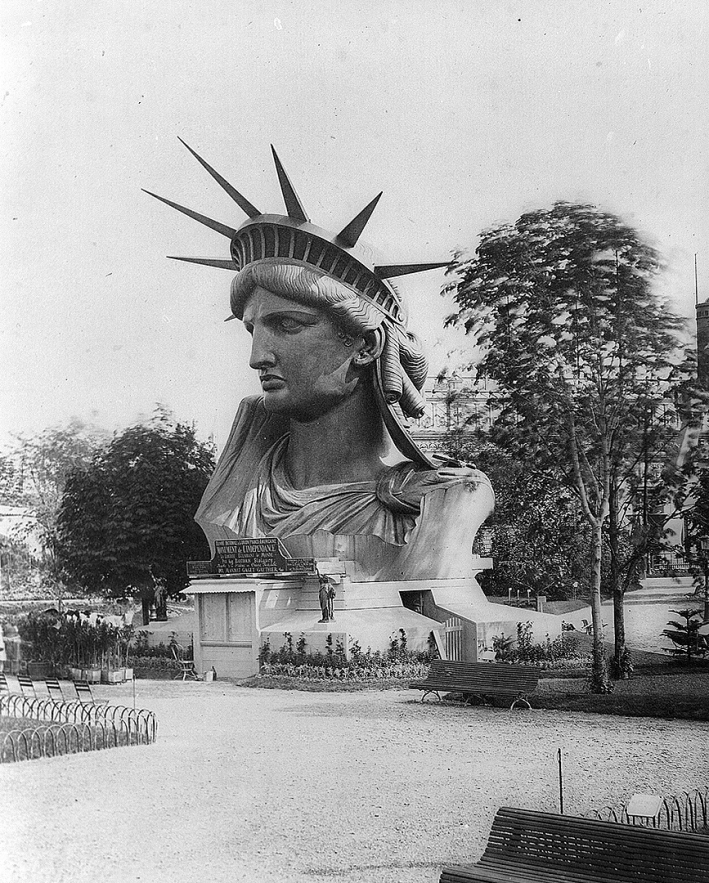 |
| The Statue of Liberty's head on display at the Paris Universal Exposition. |
1878
Statue’s head and shoulders are completed and displayed at the Paris Universal Exposition.
1879
Statue engineer Viollet-le-Duc dies and is replaced by Alexander Gustav Eiffel; French fundraising continues.
1880
Eiffel designs innovative 98-foot, 120-ton inner framework to support statue; French committee completes fundraising, U.S. fundraising continues.
1881
Statue's copper plates completed, first rivet driven by Ambassador Morton at construction site (October 24); U.S. fundraising continues.
1882
Edouard Laboulaye dies; Ferdinand de Lesseps chairs the Union; French poet Victor Hugo visits the statue, praises its "idea"; statue's arm and torch returned from New York; U.S. fundraising languishes.
1883
Statue's assembly continues in Paris; work begins on foundation of pedestal on Bedloe's Island, designed by R. M. Hunt and supervised by General Charles Pomeroy Stone; Joseph Pulitzer purchases New York World newspaper.
|
|
| Library of Congress: Pedestal for Bartholdi's Statue of Liberty on Bedloe's Island, from Harper's Weekly |
1884
Statue completed, formally handed over to U.S. ownership in Paris, accepted by Ambassador Morton; (July 4); first stone laid for pedestal on Bedloe's Island; U.S. fundraising languishes; New York Governor Grover Cleveland vetoes $50,000 state appropriation
1885
Statue of Liberty arrives in New York City from France.
Statue disassembled, crated for shipment to U.S.; Joseph Pulitzer undertakes spectacular new push for U.S. fundraising, generates $50,000 in two months; statue crosses the Atlantic in crates, nearly sinks in storm, arrives at Bedloe's Island (June17); Bartholdi arrives in U.S. (November).
1886
President Grover Cleveland officially dedicates the Statue of Liberty at a ceremony.
Pedestal completed; Eiffel's "skeleton" raised; decision is made to light the torch electrically; Statue of Liberty assembled; formal unveiling by Bartholdi at dedication ceremony held on Bedloe's Island (October 28), with U.S. President Grover Cleveland presiding.
1892
The U.S. government opens an immigration station on Ellis Island.
1903
The poem “The New Colussus” by Emma Lazarus (1849-1887) is inscribed at the base of the statue.
1924
In 1924, the federal government made the statue a national monument, and it was transferred to the care of the National Parks Service in 1933.
1956 – Bedloe Island is renamed Liberty Island
As a tribute to the Statue of Liberty which was mounted on the Bedloe Island, the island was renamed to Liberty Island. This was accomplished through a joint resolution passed by the Congress.
1984 – 1986 – The statue undergoes renovation
In 1984, extensive renovation work on the Statue of Liberty began. The work continued for two years and was completed in 1986.
On July 4 1986 the statue was reopened for its centennial and the flame was lit by President Ronald Reagan and French President François Mitterrand.
Even as the restoration began, the United Nations designated the Statue of Liberty as a World Heritage Site. On July 5, 1986, the Statue of Liberty reopened to the public in a centennial celebration.
2001
After the terrorist attacks of September 11, 2001, Liberty Island closed for 100 days; the Statue of Liberty itself was not reopened to visitor access until August 2004. In July 2009, the statue’s crown was again reopened to the public, though visitors must make a reservation to climb to the top of the pedestal or to the crown.
Watch Video about The Interesting History of The Statue of Liberty:
Brief History of the Statue of LibertyConstructing the statue wasn’t an easy feat, and not only due to its size. The United States was responsible for building and funding the 89-foot (27-meter) stone pedestal, while France focused on the statue itself, as well as shipping the sculpture in 350 pieces across the Atlantic Ocean. Both countries had funding issues, so they turned to the public for help, eventually receiving construction funds through art events, auctions, donations and public fees. Joseph Pulitzer, publisher of The World in New York City, played an important role in persuading the American public to contribute to the project. In exchange for monetary donations for the pedestal, Pulitzer printed donors’ names in his newspaper, resulting in what is now considered to be the United States’ first-ever crowdfunding campaign. And it proved successful.
Named after the Roman goddess Libertas, the robed lady’s full name is Liberty Enlightening the World. Made from iron, steel and 300 layers of hand-hammered copper, she stands approximately 111 feet (34 meters) tall, but if you measure the foundation, pedestal and torch, her full height is 305 feet (93 meters). Her right hand extends upwards to hold a 24-carat-gold gilded torch, and on her head sits a seven-pointed crown, symbolizing the seven continents and seven seas. At her feet lie broken shackles, which represent a woman free from oppression and tyranny. Her signature sea green color, also known as a patina, is the result of the natural weathering of copper, which covers the entirety of her exterior. The base of her pedestal contains a bronze plaque inscribed with a sonnet by American poet Emma Lazarus, containing the now famous lines “Give me your tired, your poor / Your huddled masses yearning to breathe free.” This has come to represent not only Lady Liberty herself but the original essence of America. Today, the statue is visited by approximately 4 million people each year. |
The Statue of Liberty was a Beacon of Hope For Global Democracy
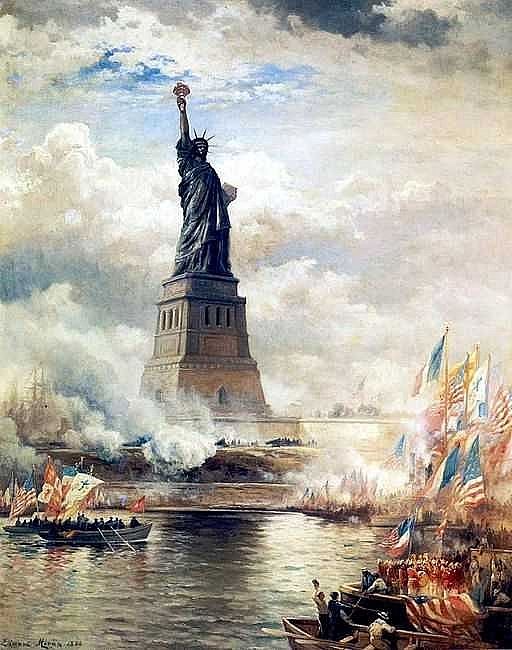 |
| Statue of Liberty Unveiled” by Edward Moran | Image Courtesy of the Museum of the City of New York |
Édouard de Laboulaye, known as the "Father of the Statue of Liberty" hoped the gift of Lady Liberty would inspire the French to fight for their own democracy in the face of a repressive monarchy under Napoleon III.
He also hoped that the gift would secure the French-American alliance. As the president of the French Anti-Slavery Society, de Laboulaye was a staunch supporter of Abraham Lincoln's emancipation efforts, as well as the passage of the 13th Amendment. When his hopes became a reality, and slavery was successfully abolished in 1865, he began working on his proposal for the statue. Finally, in 1875, the announcement of the statue was made, which would be financed by the French. The Americans would then be expected to pay for the pedestal. The full name of the statue was, and still is, Liberty Enlightening the World.
The statue's initial purpose was to celebrate the viable democracy America had built in the aftermath of the Civil War. It was scheduled to be revealed for the centennial of the Declaration of Independence in 1876, but wouldn't be finished and presented until 10 years later, on October 28, 1886, when then-President Grover Cleveland dedicated it to the Franco-American alliance on the Upper New York Bay, now known as Liberty Island.
Origins of the Statue of Liberty
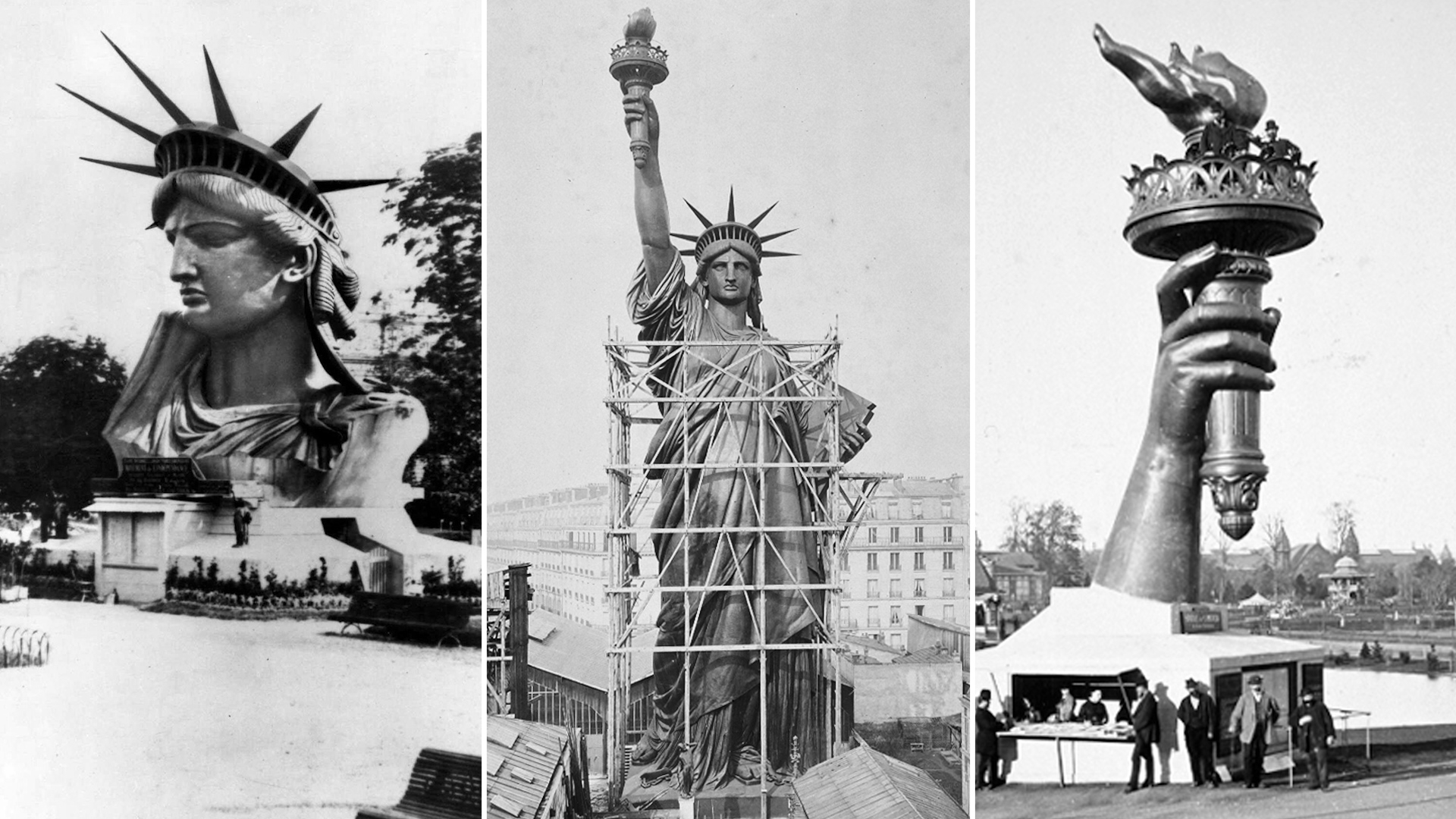 |
| Photo: washingtonpost |
Around 1865, as the American Civil War drew to a close, the French historian Edouard de Laboulaye proposed that France create a statue to give to the United States in celebration of that nation’s success in building a viable democracy. The sculptor Frederic Auguste Bartholdi, known for largescale sculptures, earned the commission; the goal was to design the sculpture in time for the centennial of the Declaration of Independence in 1876. The project would be a joint effort between the two countries–the French people were responsible for the statue and its assembly, while the Americans would build the pedestal on which it would stand–and a symbol of the friendship between their peoples.
Due to the need to raise funds for the statue, work on the sculpture did not begin until 1875. Bartholdi’s massive creation, titled “Statue of Liberty Enlightening the World,” depicted a woman holding a torch in her raised right hand and a tablet in her left, upon which was engraved “July 4, 1776,” the adoption date of the Declaration of Independence. Bartholdi, who was said to have modeled the woman’s face after that of his mother, hammered large copper sheets to create the statue’s “skin” (using a technique called repousse). To create the skeleton on which the skin would be assembled, he called on Alexandre-Gustave Eiffel, designer of Paris’ Eiffel Tower. Along with Eugène-Emmanuel Viollet-le-Duc, Eiffel built a skeleton out of iron pylon and steel that allowed the copper skin to move independently, a necessary condition for the strong winds it would endure in the chosen location of New York Harbor.
Funding the Dream
Fundraising and bringing people together have always been integral to Lady Liberty’s history. It began with efforts to finance this unprecedented undertaking. France would be responsible for creating the Statue and assembling it in the United States while the American people would fund and build the pedestal.
To raise funds in France, public fees, various forms of entertainment, and a lottery were used. In the U.S., to finance the pedestal, benefit theatrical events, art exhibitions, auctions, and prizefights were held. Poet Emma Lazarus wrote her famous sonnet The New Colossus in 1883 for an art and literary auction.
Despite these efforts, fundraising for the pedestal went slowly. To spark public action, in 1885, Joseph Pulitzer placed an ad in his paper the New York World inviting readers to donate to the cause. In exchange, Pulitzer printed each donor’s name in the newspaper. The public rose to the challenge with 120,000 people donating over $100,000 and securing the remaining funds needed for the Statue’s pedestal.
Meanwhile in France, Bartholdi required the assistance of an engineer to address structural issues associated with designing such a colossal copper sculpture. Alexandre Gustave Eiffel, just prior to creating his famed Tower, was engaged to design the massive iron pylon and secondary skeletal framework that allows the Statue’s copper skin to move independently yet stand upright.
Construction of the Statue was completed in France in July 1884. The massive sculpture stood tall above the rooftops of Paris awaiting her voyage across the sea.
Back in America that same year architect Richard Morris Hunt was selected to design the Statue’s granite pedestal, and construction got underway.
The Statue of Liberty's Original Torch
As Bartholdi envisioned it in 1874, the flame of the Statue’s torch was not to be lighted but rather made of solid copper sheet and gilded to shine brightly in daylight. But in during its first half-century, the torch underwent numerous modifications. When the Statue was dedicated in 1886, two rows of portholes had been cut from the copper at the bottom of the torch to illuminate it from inside. Six years later, an 18-inch belt of glass replaced the upper row of portholes and an octagonal pyramidal skylight with red, white and yellow glass was installed on top of the flame. Changes continued in 1916 when copper was removed in about 250 places and replaced with amber-colored cathedral glass. In 1931 a new lighting system was installed that called for two holes 16 inches in diameter to be cut into the floor of the balcony around the flame through which two projectors were installed. By this time, Bartholdi’s design was barely recognizable.
In the 1980s when the Foundation was restoring the Statue for its centennial celebration, a team of experts determined that the original torch could not be restored. A century of modifications had radically altered Bartholdi’s solid copper flame to one mainly of glass. Leaks from rain and corrosion from the elements had damaged the original torch above the handle beyond repair. It was removed on July 4, 1984 and replaced with a replica that followed Bartholdi’s design.
Today, the original torch is on display in the Inspiration Gallery of the Statue of Liberty Museum.
The Statue of Liberty Came to New York In Hundreds of Pieces
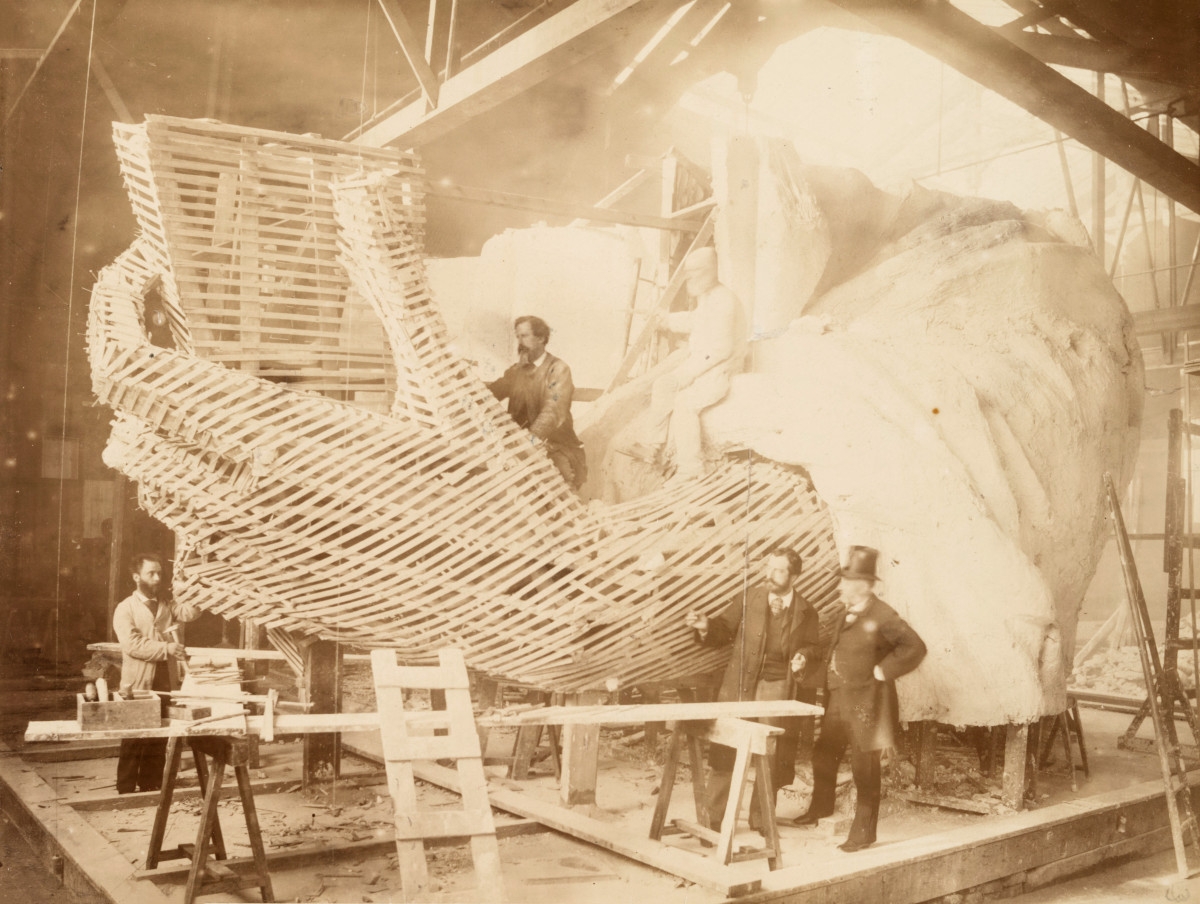 |
| Photo: history |
The statue's 350 copper pieces were transported to America in 214 crates on the French ship Isere, which almost sank in stormy seas. The statue's parts alone took long to ship across the Atlantic and took a lot longer to fully assemble.
A decade before she would be fully constructed, her arm and torch were displayed in Madison Square Park, and at the Centennial Exposition in Philadelphia to secure further funding. Believe it or not, building Lady Liberty costs what equates to around $5.5 million today. And that was on the American side. The French paid millions of francs more to have it constructed as a diplomatic gift.
Luckily, the instructions were a little better than the likes of an Ikea bookshelf. Sculptor Auguste Bartholdi devised an extensive and unique assembly plan. Each piece would be secured within an iron framework, supported by wooden beams. It took four months alone just to hoist her onto her mighty pedestal. It's no surprise given she weighs 204 metric tons, and wears a size 879 shoe.
The Statue’s Design Was Meant for the Suez Canal
In the late 1860s, before he was ever asked to design the Statue of Liberty, Bartholdi submitted a very similar idea for the entryway of Egypt’s Suez Canal.
Unfortunately, his design was rejected due to the high cost. As luck would have it, he was able to use the same concept years later when asked to create the Statue of Liberty. While specific changes were made for the American version, overall the two were very similar — a robed female figure bearing a torch.
Parts of the Statue Arrived in America Early
As yet another example of a crowdfunding tactic, the disembodied hand and torch of the Statue of Liberty sat in Madison Square Park in New York for six years. This was done to inspire the Americans to start their own donation pool.
Souvenir photographs were sold and people could even pay to climb a ladder and stand on the torch balcony. Definitely a unique form of advertising.
There’s an Old War Fort Under the Statue’s Pedestal
Before opening day, before the pedestal, even before Bartholdi, there was already a huge structure sitting on Liberty Island.
Fort Wood is the star-shaped building underneath the pedestal. It was built long before anyone even thought of building a statue in New York. In preparation for the War of 1812 against the British, U.S. troops built a series of forts around New York Harbor to protect the city from invasion. Oddly enough, the British never attacked the harbor, so the fort was never used for battle.
Today, it almost seems like the fort and pedestal are one piece since the stone used for the pedestal was chosen specifically to match.
Statue of Liberty Fast Facts
• The statue sways 3 inches (7.62 centimeters) in the wind; the torch sways 5 inches (12.7 centimeters).
• Visitors climb 354 steps (22 stories) to look out from 25 windows in the crown.
• The statue—151 feet, 1 inch (46 meters, 2.5 centimeters) tall—was the tallest structure in the U.S. at that time.
• Engineer Gustave Eiffel, who would later design the Eiffel Tower in Paris, designed Liberty’s “spine.” Inside the statue four huge iron columns support a metal framework that holds the thin copper skin.
• Frédéric-Auguste Bartholdi knew he wanted to build a giant copper goddess; he used his mother as the model.
• The statue is covered in 300 sheets of coin-thin copper. They were hammered into different shapes and riveted together.
• The arm with the torch measures 46 feet (14 meters); the finger, 8 feet (2.4 meters); the nose, nearly 5 feet (1.5 meters).
• Seven rays in the crown represent the Earth’s seven seas.
Why Don't They Clean the Statue of Liberty?Cleaning the green patina from the Statue of Liberty could do more harm than good, according to National Park Service spokesman Jerry Willis in a statement to AM New York. But that doesn't mean there are no maintenance chores. A team of 24 caregivers from the National Park Service and several contractors maintain the statue and tend to groundskeeping, clear drainage grates, and keep the plumbing, electrical and HVAC systems working. The popular attraction sees roughly 4.5 million visitors a year who cause constant wear and tear on the doors, elevators and painted surfaces. The last time major restoration work was undertaken was in 1982 when President Ronald Reagan appointed Lee Iacocca, then chairman of Chrysler Corp., to lead a private-sector effort. During the renovation, the torch was replaced because the supporting structure of the Statue of Liberty’s arm had been damaged over the years as rain fell through the torch’s windows. The new torch is still made of copper, but it's covered in 24-karet gold leaf, the article said. Visitors to Lady Liberty can view the original torch, which is on display inside the Pedestal lobby. |
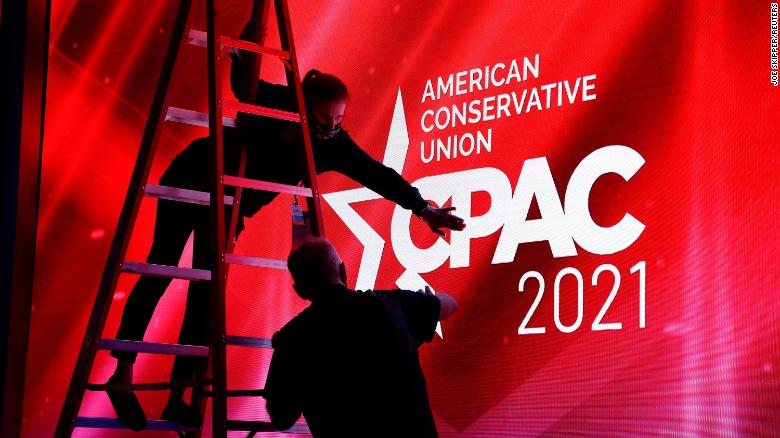 FACTS about Trump's Golden Statue at CPAC 2021: Outlook, Reactions FACTS about Trump's Golden Statue at CPAC 2021: Outlook, Reactions A golden statue of the Former President Donald Trump is popping up at the Conservative Political Action Conference (CPAC) 2021 where Trump is slated to ... |
 Top 10 Tallest & Beautiful Statues in the World Top 10 Tallest & Beautiful Statues in the World There are tall and exclusive statues representing either prominent historical events or are related to outstanding personalities and are part of tourism globally. |
 Top 25 Amazing Facts About the Statue of Liberty Top 25 Amazing Facts About the Statue of Liberty In this article, we are giving 25 ‘wow facts’ about the Statue of Liberty for the knowledge of kids, students, and curious people. |

